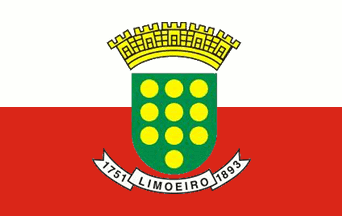 image by Dirk Schönberger, 13 May 2011
image by Dirk Schönberger, 13 May 2011
Source: http://www.limoeiro.pe.gov.br/simbolos.aspx

Last modified: 2012-04-07 by ian macdonald
Keywords: pernambuco | limoeiro |
Links: FOTW homepage |
search |
disclaimer and copyright |
write us |
mirrors
 image by Dirk Schönberger, 13 May 2011
image by Dirk Schönberger, 13 May 2011
Source:
http://www.limoeiro.pe.gov.br/simbolos.aspx
Horizontally divided, white over red, with the municipal arms centerd.
Official website at
http://www.limoeiro.pe.gov.br
Dirk Schönberger, 13 May 2011
The municipality of Limoeiro (55,390 inhabitants in 2010; 270 sq. km) is
located in eastern Pernambuco, 80 km of Recife. Limoeiro originates in an Indian
hamlet evangelized in 1730-1740 by Father Ponciano Coelho. The district of
Limoeiro was established on 16 June 1786. The municipality of Limoeiro was
established on 6 April 1893. The name of the town ("lemon-tree") alludes to the
alleged foundation of the chapel dedicated to the Virgin of the Presentation.
When Father Ponciano decided to build a chapel in the village of Poço do Pau, on
the estate owned by Alexandro de Moura, the statue of the Blessed Virgin
disappeared from the chapel and was found in a lemon-tree; the event repeated several times, until Ponciano understood that
the Virgin wanted a chapel to be built near the lime-tree, at the site of
the present day's parish church.
The symbols of Limoeiro were designed by
the famous novelist, poet and playwright Ariano Suassuna (b. 1927). Born in
Nossa Senhora das Neves (today's João Pessoa, the capital of Paraíba), Suassuna studied law in Recife, where he founded the Pernambuco Students'
Theatre, together with Hermilo Borba Filho. His play "Auto do Compadecida"
(1955) was named in 1962 by Sábato Magaldi "the most popular text in modern
Brazilian theatre". Suassuna and Borba Filho founded in 1959 the Nordeste
People's Theatre. In 1970, Suassuna established the "Movimento Armorial",
interested in the development and study of the traditional people's culture.
Elected in 1989 at the Brazilian Academy of Literature, Suassuna was featured
in 2004 in the documentary "O Sertão: Mundo de Ariano Suassuna", shot by
Douglas Machado.
White represents peace while red represents vitality.
Green recalls the main color of the national flag. Yellow represents gold.
More specifically, the yellow disks represents lemons ("limões"), making the
arms canting. The scroll is charged with the years of first colonization
("1751") and political emancipation ("1893").
http://www.limoeiro.pe.gov.br/simbolos.aspx
The flag can be seen on
photos taken during the civic parade held on 7 September 2009.
http://www.limoeiro.pe.gov.br/album.aspx?evento=108
http://www.limoeiro.pe.gov.br/album/108/DSC_0693.jpg
http://www.limoeiro.pe.gov.br/album/108/DSC_0628.jpg
Ivan Sache,
6 March 2012